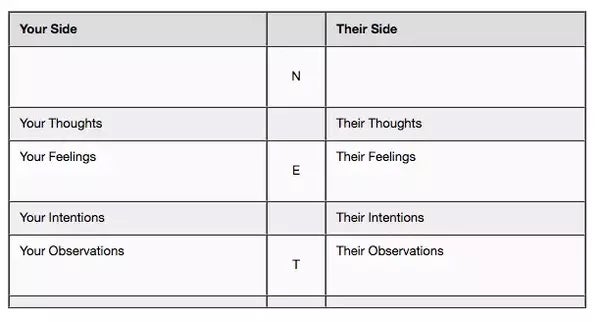
What is the best way to approach a difficult conversation you have been avoiding? originally appeared on Quora - the place to gain and share knowledge, empowering people to learn from others and better understand the world.
Answer by Osman Ahmed Osman, Engineering Manager, on Quora:
If you realize you’ve been avoiding a difficult conversation, that probably means you need to have it as soon as possible. The longer you wait, the harder it will get.
Difficult conversations will always be hard and uncomfortable, but the right approach can help make them more constructive. There are two frameworks I've found particularly enlightening. Let's call the first the “Harvard framework”, since it will be most familiar to students coming out of Harvard Business School or Harvard Law School (it is discussed in a book called Difficult Conversations: How to Discuss What Matters Most). The basic idea is that any conversation is actually three simultaneous conversations:
- A “What Happened?” conversation: What actually happened? Which of those events are important, and why?
- A Feelings conversation: What emotions did those events spark in each person? What emotions were expressed and how?
- An Identity conversation: How does the conversation or events reflect on a person's own perception of who they are? Does it reinforce insecurities (e.g. “I am too emotional?” or “I am a selfish person?”) Does it undermine their own self-perception (e.g. “Am I not as strong as I think?” or “Am I not as caring as I think?”)
Once you break-down a conversation into these three sub-conversations, it becomes easier to identify some of the traps you can fall into in each one. For example, one trap in the “What happened?” conversation is assuming that one’s observations are facts that are interpreted in the same way by the other person, or assuming the other person's intentions. As for the "Feelings" conversation, one trap is not acknowledging or giving validity to your own or the other person's feelings. Another is letting them cloud your thoughts or behavior. The "Identity" conversation is actually the trickiest one, since it can throw a person “off-balance” into a mini-identity crisis. It is extra complicated since each person is probably having their own internal "Identity" conversation. It’s also easy to fall into an “all-or-nothing” trap: “I am a careless person” rather than acknowledging the complexity of ourselves.
This might seem a little abstract, so in the interest of brevity I'll just invite you to read the book - it really changed how I think about and approach communication both professionally and personally.
I'll refer to the second framework as the “Stanford” framework, which I'm told is taught in a class called Interpersonal Dynamics, which is also known as the “Touchy-Feely” class (though I'll never know for sure because I got rejected from Stanford's GSB… sniff). This one is a little simpler, in my opinion, and is called “staying on your side of the net”. The idea is to break down everything into things that you can know with certainty, and things that you can't.

As in tennis or volleyball, you should not “cross the net”. In other words, you should not assume you know, with certainty, anything that is on the other person's side of the net. Do not assume you understand their feelings, or their intentions. A good summary of all this, with examples, is at this link (which is where the image is from as well). I find the Harvard framework more powerful (in particular, the "Identity" conversation was eye-opening), but harder to carry around in your head. The Stanford framework is simpler to remember, and hence simpler to adhere to.
This question originally appeared on Quora - the place to gain and share knowledge, empowering people to learn from others and better understand the world. You can follow Quora on Twitter, Facebook, and Google+. More questions:
